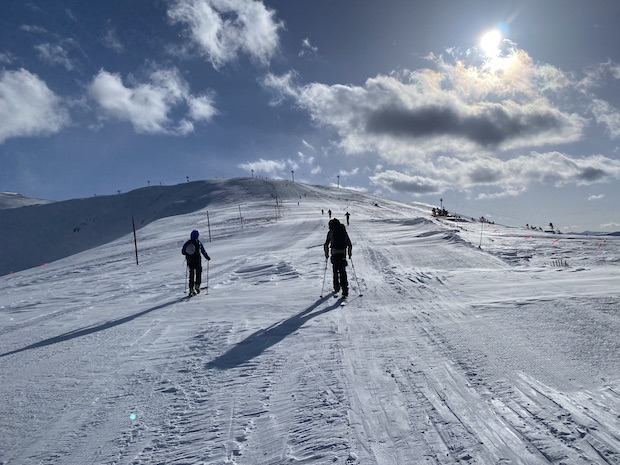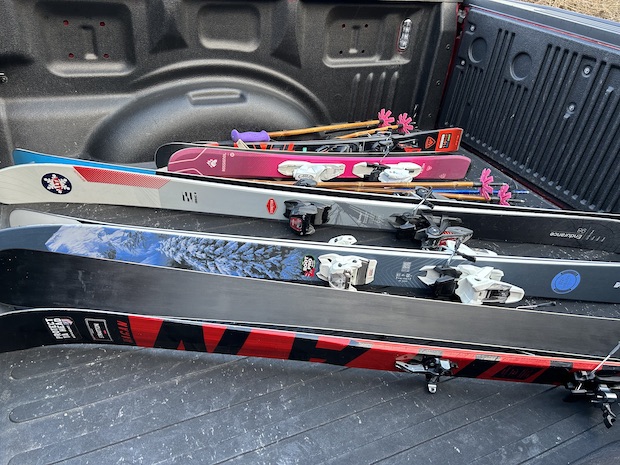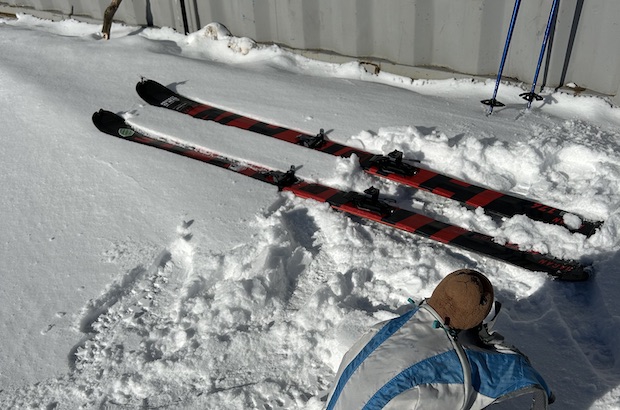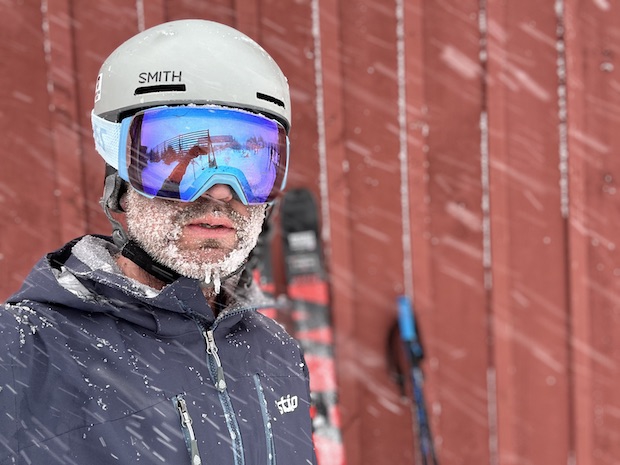N=1 Experiment: Uphill Skiing as Run Training

As I wrote in my last article, our family spends every weekend and holiday period from the first weekend of December until the last weekend in March at the mountain. Our daughter has wanted to be a ski racer since she first got on skis at three years old, and has now progressed to a fully fledged speed demon who, at 7, nearly beat me through gates. (Sidebar: I thought I’d have a lot longer to be faster than her. Think I have maybe one more year left.)
Now, we are the “rare” ones in our program in that we don’t own a home or condo on the mountain; instead, we commute the roughly 40 miles each way every day. We manage to both be “locals” and “from away” at the same time. That said, the commute means our morning routine every Saturday, Sunday, and holiday period looks something like this:

5 AM: alarm
Next hour or so: Morning farm chores — feed and water the chickens and rabbits, clean, finish packing, ensure driveway is clear
6:15 AM: wake up Ivy (if not up already), pack breakfast / get ready for departure
6:45 AM: out the door
6:52 AM: arrival to Dunkin’ for high test coffee
7:55 AM: arrival to Stratton
8:00 AM: begin gear up
8:15 AM: on the snow
8:25 AM: programming begins
It is a lot. Rinse, lather, repeat for 18 weekends plus December and February breaks.
We do indeed love our home mountain; Stratton is owned by Alterra, the mountain collective behind the IKON Pass, which enables us to visit Eric and the Slowtwitch home offices in Utah each year while getting to ski at Alta/Snowbird, Snowbasin, Deer Valley, and more. Stratton also generally has free parking, a good village, hidden gems of terrain if you know where to look, a great patio bar (shout out to Nugget and The Drift!), and a couple of good shops if you need something in a pinch.
But, most importantly for me and this article, Stratton offers a free uphill program. Acquired at Guest Services, the Uphill Pass allows you access to snowshoe, skin, or split board your way up certain trails during daytime / lift operations hours. With the longest route at 2.4 miles and total elevation just under 1800 feet, there’s a variety of terrain options based on how hard you’d like to go and/or your tolerance for cold.

I started skinning a few years ago, in part due to being blacked out of our season’s pass. But I really focused on it more this year because I’ve got IRONMAN Lake Placid on the docket. As you can tell from the morning routine, if I wanted to actually sleep a decent amount, I can’t get a morning workout in before departure — and as I’ve gotten older, I prioritize sleep over just about anything. We also don’t return home from the mountain until after 4 PM, and I am terrible at working out late unless there’s a team Zwift race.
That leaves during the program window: 8:25 AM to 11:30 AM, and then 12:30 PM to 3:00 PM, and with the option of swimming or running at the Stratton Fitness Center, or going uphill. Now, I like the Fitness Center. It’s a saline pool, and usually kept at a good temperature. They also have lovely treadmills. It’s also $25 per day to visit. And I already spend a decent chunk of change on our Y membership. So, as they say, when in Rome…
I went uphill. A lot.
Every Saturday, at minimum, there’d be a full lap, top to bottom. The goal of any lap, for me, was to climb up and ski back down in under an hour. Most of the time, I’d get at least two laps in, alternating ways up the mountain (there are three routes that reach the summit; two from the main base, and one from the Sun Bowl). The “big” goal for the year was to be able to get three full ascents in before I needed to be back to base to pick up Ivy for the lunch window. I didn’t quite get there, turning around on the third lap 75% of the way up.

While climbing, I’d look to approach it similar to my running heart-rate zones — look to settle into my “Z1” (I use the classic ZR-Z1-Z2-Z3-MSE system), with the hardest pitches allowed to dip into Z2, unless I was trying to “race” the climb. Most often this would serve as my “long run” for the week, as the total climb times would approach 90 minutes to two hours. And fueling would be most similar to how I’d treat a run, with the majority of intake being Gatorade Endurance.
Here’s the thing that I’ve noticed, now coming back into a more traditional triathlon build with ski season ending — my running has drastically improved, particularly on the uphill. Even at my absolute peak of triathlon fitness a decade ago, I have always lagged behind on hills. I’d yo-yo away from the group I’d be running with and need to floor the downhill or flat sections to try to keep up. And now I feel like I can just grind my way through any elevation change. I think that’s due to a couple of reasons.
First: the mental component of having faced average grades of 15-18% while skinning uphill makes run hills look tiny by comparison (also filed to: you really get a newfound appreciation for just how steep “beginner” terrain can be at mountains when you climb them). Second: leg strength. Jordan Rapp once wrote that he viewed an IRONMAN run to be a strength, not speed, run. It took me a long time to understand that phrasing — especially given the speeds with which pros now run an IRONMAN marathon. But I think I get it now — you have to have sufficient power and endurance in the muscle itself. I don’t fear the legs giving out before my aerobic fitness while maintaining pace on the hills.
The final benefit, at least for me, is overall health. It’s the first time I can remember going into an IRONMAN build where my body isn’t falling apart around me. And I feel mentally ready to put in the grunt work, which will include many, many hours in my basement on Zwift. It’s not a bad place to be in heading into the 3+ month build towards Lake Placid — and hopefully, my first triathlon finish since 2018.

